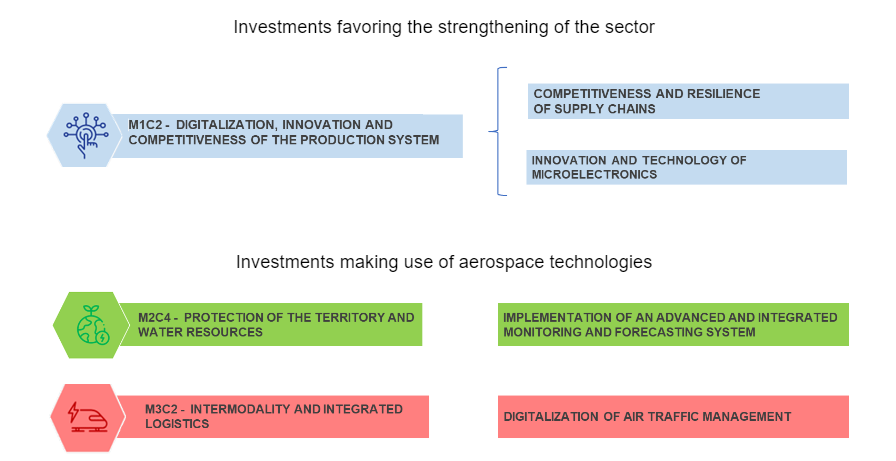
The aerospace industry has an increasingly important role in Italy’s economic development. The Italian Aviation Industry ranks 4th in Europe and 7th in the world by size, with leadership positions in civil helicopters, regional aircraft and propulsion. The technological skills and know-how of Italian aeronautics and space companies, combined with the increasingly advanced technological knowledge in production processes, have become critical growth drivers for Italy in the sector.
In this section you will find:
-
Italian Aerospace sector overview
-
Main aerospace players
-
Snapshots of the sector’s competitive advantages
-
Funds allocated by the Italian NRRP to the aerospace industry
Italian Aerospace sector overview
Italy has a long tradition in the aerospace industry: it was the first country in the world to build a certified convertiplane for civilian use, was the third country in the world to launch a satellite into orbit, and more than half of the pressurized volume of the international module at the International Space Station was made in Italy.

Italy boasts many highly-specialized aerospace clusters and districts located in 11 regions, and they are all part of the Italian National Aerospace Technology Cluster (CTNA). Each regional technological district has its own specific strengths with highly specialized businesses aimed at developing innovative applied technologies in the aerospace sector.
 |
There are Large System Integrators (satellites, ground infrastructures and launching systems), small system integrators (payload and satellites of all sizes) and a vibrant and wide community of small and medium companies, including start-ups and spin-offs with very good performances and excellent potential for growth.
Main aerospace players
Leonardo is the leading aerospace company in Italy, the 5th in Europe and the 10th globally. With over 31,000 employees in Italy and 70 facilities, Leonardo is present in 15 Italian regions, with a particularly high industrial concentration in Lombardy, Lazio, Campania, Piedmont, Apulia, Liguria and Tuscany.
Italy is home also to important Public R&D Centers enabling Italian enterprises to compete at high levels on the international markets.
-
Italian Aerospace Research Center (CIRA): it promotes research and technological development in the fields of space and aeronautics;
-
National Research Council (CNR): it is the largest public research institution in Italy performing multidisciplinary activities. It includes, among its departments, the Department of Physical science and material technologies (12 research institutes), the Department of Engineering, ICT and technologies for energy and transportation (15 research institutes), the Department of Chemistry and materials technology (11 research institutes);
-
National Agency for New Technologies, Energy and Sustainable Economic Development (ENEA): it operates in research, technological innovation and the provision of advanced services to enterprises, public administration and citizens in the sectors of energy, the environment and sustainable economic development;
-
National Institute of Astrophysics (INAF): it is the main Italian Research Body for the study of astronomy and astrophysics;
-
National Institute for Nuclear Physics (INFN): it is the Italian research agency dedicated to the study of the fundamental constituents of matter and the laws that govern them.
Research activities also take place at Universities that have a long tradition of collaboration in scientific and industrial programs of aerospace engineering.
Italy is the ideal destination for aerospace foreign companies and investors, thanks to a strong industrial base, the presence of key players and a high level of R&D.
Competitive advantages
Discover why Italy is a great place to invest and get detailed insights into Italian Aerospace Industry.
Easy access to European Aerospace Industry
A multi-modal logistic infrastructure connects Italy to the main European aerospace countries and to extra-European markets.
Top investing countries in the space economy
According to the G20 Government Space Budget, Italy is the 7th country in the world and the 1st country in Europe that invests the most in space in terms of share of GDP.

Excellent scientific production
Italy ranks amongst the top 10 countries for the number of citations in Aerospace engineering and Space and Planetary Science. This reflects the high quality of Italian scientific research in the field.
Italian companies, universities and research centers actively participate to European research programs as well as in national and regional ones, whose objectives for aeronautics are sustainability and eco-compatibility.

Home to numerous key industrial players and multinationals
Many foreign companies have already chosen Italy for their business activities and partnerships.
Italian companies, universities and research centers actively participate in major international research programs as well as in national and regional ones, whose objectives for aeronautics are sustainability, eco-compatibility and digitalization.

Top Education system and Talents
Italy boasts numerous specialized human resources and new graduates with a high level of training. Several universities train Aerospatial and astronautic engineers, and only in 2020 Italy counted 48k graduates in engineering courses. Furthermore, Italian Universities are interesting partners for customized Research and Training activities: several international companies collaborate with our universities to create joint labs (like TAL - Turin Additive Laboratory by Avio Aero, together with the Polytechnic University of Turin) or advanced training courses (like the Aerotech Academy by Leonardo company and the University of Naples "Federico II").

Italian National Recovery & Resilience Plan (NRRP)
The National Recovery and Resilience Plan provides investments directly and indirectly linked to the aerospace sector within Mission 1 C2: Digitalization, Innovation and Competitiveness of the Production System. In particular
-
Directly related investments in Satellite technologies and space economy;
-
Investments favoring the strengthening of the sector, foreseeing financial support for investment projects with a significant impact on the Italian production chains currently existing, as well as on emerging ones;
-
Investments making use of aerospace technologies, like the implementation of an advanced and integrated monitoring and forecasting System and the digitalization of air traffic management.




